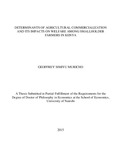| dc.description.abstract | Rampant poverty and food insecurity among rural farming households in developing countries have been linked to poor performance of the agricultural sector. In Kenya, for example, statistics show that rural households are mainly dependent on agriculture, are the poorest and most food insecure in the country. Majority of these households are smallholder farmers and account for about 75% of the total agricultural output and 70% of marketed agricultural produce in the country. However, empirical evidence shows that agricultural output market participation is very skewed in the sense that about 20% of smallholder households account for over two thirds of the marketed volumes. Reasons for this limited and skewed commercialization are not clear. Similarly, there is limited empirical evidence to demonstrate the impact of agricultural commercialization on smallholder welfare.
Using two year panel data collected from randomly selected households in five districts in Kenya, this study investigated the determinants of household agricultural commercialization decision and intensity using the double hurdle model based on a comprehensive household commercialization index constructed from the value of all crops produced on the farm. On the other hand, impacts of agricultural commercialization on smallholder welfare (food security and poverty) were estimated using the endogenous switching regressions. Both the double hurdle and endogenous switching regression models were estimated using a fixed and random effects hybrid framework called correlated random effects.
The results showed that bigger farm size and more soil fertility affected household commercialization positively. Similarly, access to farm input credit, contacts with extension staff and membership to rural agricultural production networks positively determined agricultural commercialization. Mobile phone ownership, ownership of local means of transport like bicycles, wheelbarrows etc. and transport cost to main markets (proxy measure for household remoteness) affected smallholder commercialization significantly. Ownership of mobile phone and local transport means affected smallholder commercialization positively while transport costs to the main market (household remoteness) was negatively related to commercialization. On the other hand, results from impact assessment showed that agricultural commercialization significantly reduces food insecurity and poverty among commercialized and non-commercialized households. | en_US |

